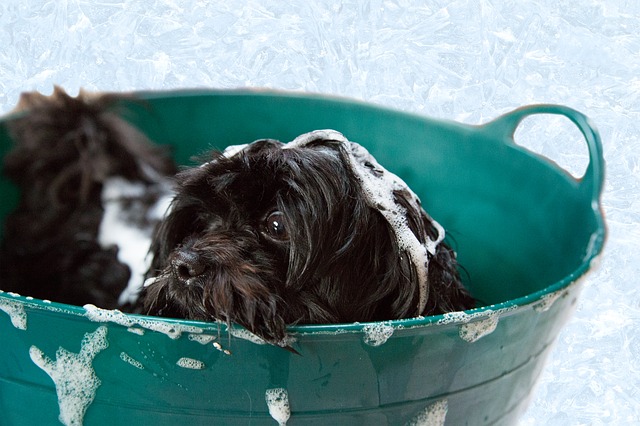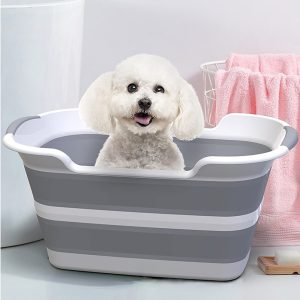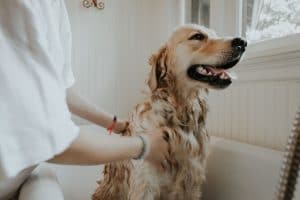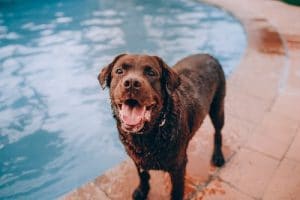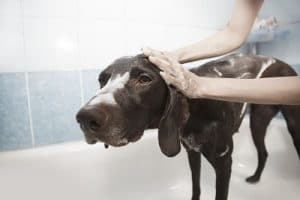Regular dog baths are not just about keeping your doggo looking and smelling fresh (although that’s a nice bonus); they are essential for hygiene and health.
Think about it – dirt, dust, and yes, even those puddles Jeff (my dog) loves so much can carry all sorts of nasties.
Fret not; there’s a solution to everything, and I have come bearing gifts. Unlike us, dogs don’t need to be bathed almost every day.
Short-haired dogs should only be bathed once a month unless your dog is dirty from being outside. And long-haired breeds don’t need more than two to three baths yearly. They’ll require regular paw cleanings and grooming visits for their coats.
Breeds with thick or water-repellent coats should only be bathed per your vet’s advice. Overbathing can strip their coats of natural oils, leading to skin problems.
How to bathe your dog properly?
Step 1: Gather supplies to prepare the bath.
Here’s your checklist for a successful dog bath:
- Dog-specific shampoo
- Dog-specific conditioner
- Few old towels
- Dog brush
- Non-slip mat or towel
- Leash or harness (optional)
- Container or cup
- Dog treats
- Bathtime dog toys
Step 2: Brush your dog’s coat beforehand.
Matted hair is the worst. They trap water and soap, leading to skin irritations down the line. So, by brushing your dog’s coat beforehand, you’re preventing potential tangles and ensuring that the bathwater can reach their skin more effectively.
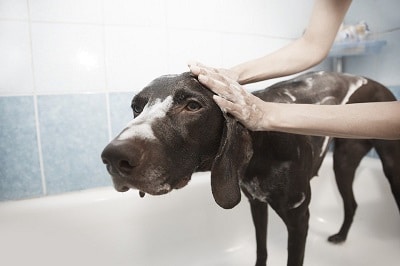
Step 3: Get your dog into the bathing area.
Dogs can get excited or nervous during bathtime. Slipping in the tub or shower will lead to accidents or make them even more anxious.
First, use a non-slip mat or towel at the bottom of the bathing area to prevent slips and slides. The second suggestion is optional, but you could use a leash or harness to keep your dog in the bathing area if they tend to get fidgety.
Let them sniff around, get used to the sights and sounds, and even offer treats to create a positive association.
Step 4: Wet your doggo’s coat.
Gently wet your dog’s coat with lukewarm water. Start from their neck and work your way down, avoiding their head. A handheld showerhead will get you better control and thorough rinsing if possible.
Step 5: Apply shampoo.
Use a dog-specific shampoo and lather it evenly across their coat. Be sure to avoid their eyes and ears during this step.
Note: Consult your veterinarian for a suitable shampoo if your dog has specific skin or coat issues.
Step 6: Massage and scrub their coat.
Gently massage the shampoo into your dog’s coat, paying attention to areas where dirt and grime accumulate. Use a dog or rubber brush to scrub through their fur and help remove loose hair and tangles.
Step 7: Rinse thoroughly.
You must ensure no residue is left on your dog’s skin. Start rinsing from the neck down, moving methodically to cover their entire body.
Be extra careful when rinsing around their face, avoiding water in their eyes and ears.
Step 8: Re-apply shampoo and rinse again.
According to professional groomers, it’s best to apply shampoo twice. The first round usually removes on-the-surface dust, while the second gets in there and achieves ideal results.
Step 9: Apply dog-friendly conditioner.
Dog shampoo can also accidentally remove natural oils from a dog’s coat, so it’s best to apply the conditioner and rinse again for rehydration.
Step 10: Dry your dog.
After the bath, wrap your dog in a dry towel and gently pat them dry. If your dog has a long or thick coat, use a dog-specific dryer on a low, cool setting to speed up the drying process.
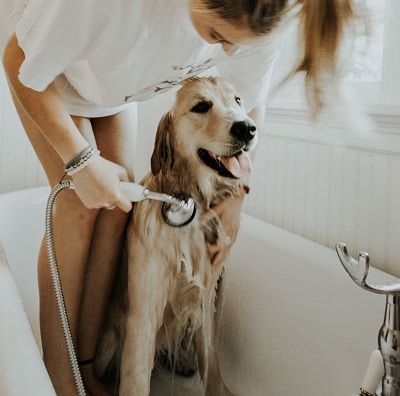
How do I clean my dog’s ears and eyes?
Cleaning your dog’s sensitive areas like ears and eyes requires gentle and careful handling to avoid discomfort or injury. Here’s how to do it effectively:
Cleaning Ears:
1. Dampen a soft cloth or cotton ball with lukewarm water.
2. Gently wipe the outer part of your dog’s ears, avoiding the ear canal.
3. If you notice excessive earwax, redness, or a foul odour, consult your vet for professional ear cleaning.
Cleaning Eyes:
1. Use a clean, damp cloth or a specialised eye wipe for dogs.
2. Gently wipe around your dog’s eyes, moving from the inner corner outward.
3. Be cautious not to touch the eye, and avoid using harsh chemicals.
How do I dry and groom my dog after bathing?
Step 1: Grab a clean, absorbent towel and gently pat your dog dry. Avoid rubbing vigorously, or you’ll end up tangling their fur. If your dog enjoys it, you can even turn this into a little bonding time by giving them a gentle massage with the towel.
Now, you could also use a dog-specific dryer if you own one. They’re designed to blow warm air and can help speed up the drying process.
Remember to use a low-heat setting to avoid discomfort for your furry friend. Keep the dryer safe from their skin, and use your free hand to fluff their fur as you go.
Speaking from my own experience with Jeff, he’s not a huge fan of the dryer. But he’s become more tolerant with some tasty treats and positive reinforcement.
Step 2: Once your dog’s coat is dry, comb it gently with a dog brush. Start at the tips and gradually work your way up to the roots. This process keeps their fur in tip-top shape and prevents discomfort for your pup.
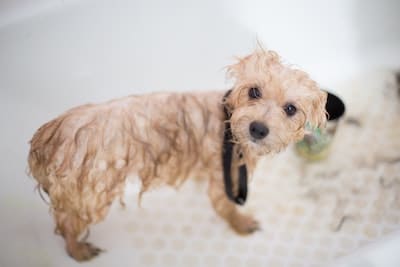
You could also comb outside if your dog is more comfortable there. Basically, you guys can leave the bathroom once your canine is dry.
Do dogs like warm or cold baths?
There is no one-size-fits-all water temperature preferred by old dogs. Like us, dogs have their preferences of whether they prefer warm or cold baths.
Generally, it’s best to use lukewarm water when bathing your dog. It’s a Goldilocks solution – not too hot to scald your pup and not too cold to give them the shivers. Lukewarm water is typically the most comfortable and safest option for your dog.
The key is to gauge your dog’s reaction. You’re on the right track if your mutt seems comfortable with the water temperature.
What type of shampoo should I use?
The answer lies in understanding your dog’s unique needs.
Dogs have different coat types and skin sensitivities, and choosing the appropriate shampoo can make a difference. Here are a few pointers:
- Coat Type: If your dog has a specific coat type, such as long, short, curly, or double, shampoos are tailored to each.
- Skin Conditions: If your dog has skin issues or sensitivities, consult your veterinarian for a recommendation. They can suggest a medicated shampoo or a hypoallergenic option to address specific concerns.
- Dog-Friendly Products: Always prioritise shampoos specifically formulated for dogs. Human shampoos have a different pH and alkalinity, which may irritate your dog’s skin.
- Ideal Conditioner: Shampooing can rid your dog’s coat of its natural oils. Using a suitable conditioner will rehydrate their skin and keep the coat healthy.
How do you choose the best location?
A dedicated dog shower is the crème de la crème to bathe your dog at home if you can afford one. These specialised areas are purpose-built for dog baths and come equipped with all the amenities you could dream of.
It’s understandable and quite common if you don’t have it. I didn’t have one for the longest time, either.
For smaller breeds or puppies, a sink can be an excellent alternative to a full-sized tub. It provides a confined and cosy space to help your little one feel more secure during the bath. Plus, it’s the right height to save your back from unnecessary strain.
You can rely on your trusty bathtub or an equivalent large container for medium to large breeds. The key here is space. You’ll need room for your dog to stand comfortably without feeling cramped.
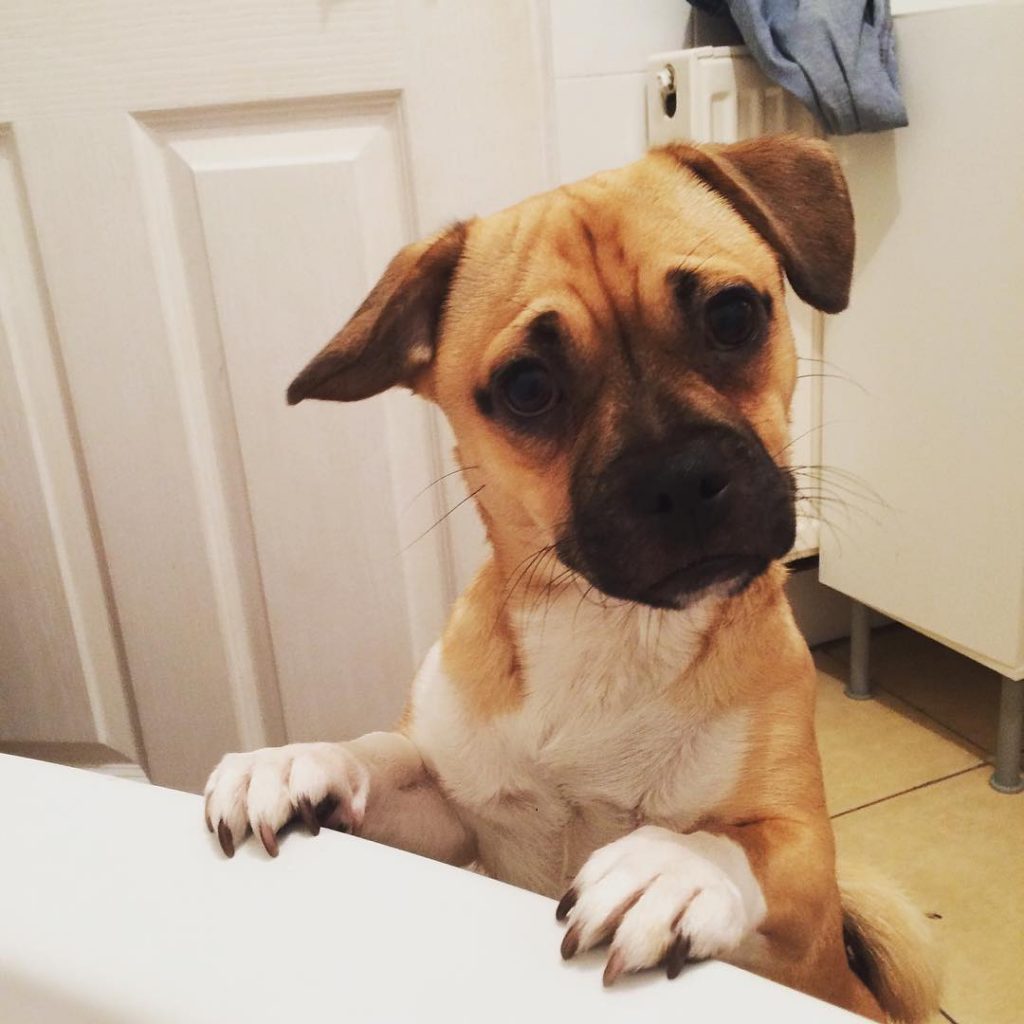
Frequently Asked Questions
What is the best time to bathe your dog?
There’s no strict rule, but many dog owners find that bathing their dogs in the morning or early afternoon works well. It allows your dog plenty of time to dry before bedtime and avoids any chilliness that might come with evening baths.
Can I use human shampoo on my dog?
You cannot use human shampoo on your dog. Human shampoos are formulated for our skin’s pH levels, which differ from those of dogs. Human shampoo can strip your dog’s skin of natural oils, leading to dryness and irritation.
How do I prevent my dog from shaking water everywhere after a bath?
Technically, you can minimise the splatter by gently squeezing excess water from your dog’s coat with a towel before they can shake. Keep a towel handy to catch the initial shake, and be prepared for some droplets.
What if my dog hates baths and becomes aggressive or fearful?
Start by making the bathing area a comfortable and inviting space. Use treats, praise, and gentle handling to gradually desensitise your dog to the bath. If your dog’s anxiety persists, consider consulting a professional dog trainer or behaviourist for further guidance.
